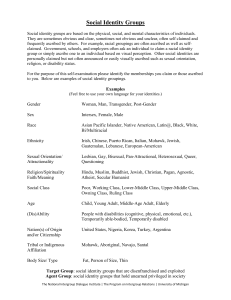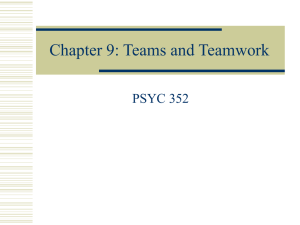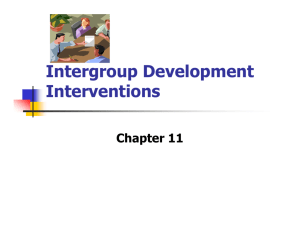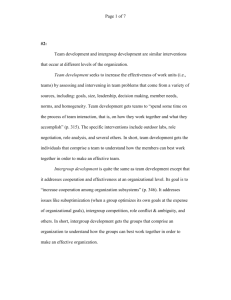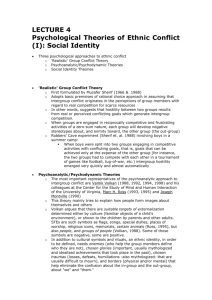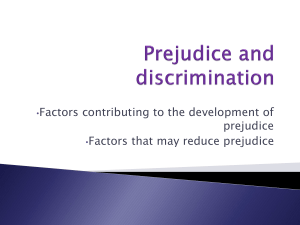DSP Chapter 12
advertisement
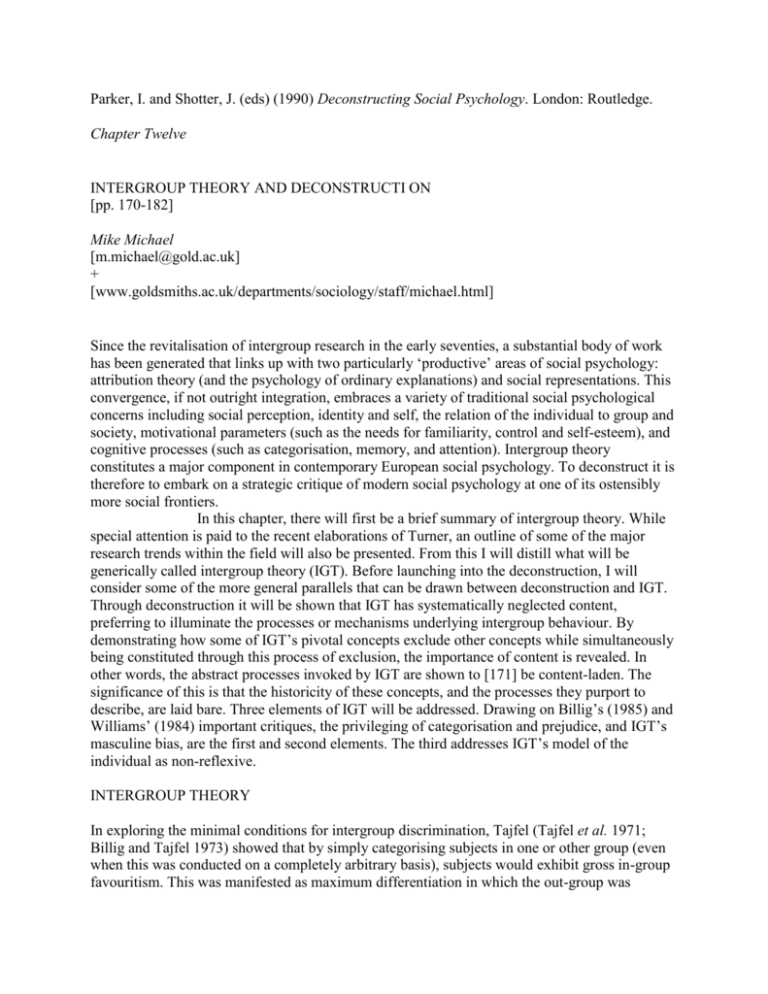
Parker, I. and Shotter, J. (eds) (1990) Deconstructing Social Psychology. London: Routledge. Chapter Twelve INTERGROUP THEORY AND DECONSTRUCTI ON [pp. 170-182] Mike Michael [m.michael@gold.ac.uk] + [www.goldsmiths.ac.uk/departments/sociology/staff/michael.html] Since the revitalisation of intergroup research in the early seventies, a substantial body of work has been generated that links up with two particularly ‘productive’ areas of social psychology: attribution theory (and the psychology of ordinary explanations) and social representations. This convergence, if not outright integration, embraces a variety of traditional social psychological concerns including social perception, identity and self, the relation of the individual to group and society, motivational parameters (such as the needs for familiarity, control and self-esteem), and cognitive processes (such as categorisation, memory, and attention). Intergroup theory constitutes a major component in contemporary European social psychology. To deconstruct it is therefore to embark on a strategic critique of modern social psychology at one of its ostensibly more social frontiers. In this chapter, there will first be a brief summary of intergroup theory. While special attention is paid to the recent elaborations of Turner, an outline of some of the major research trends within the field will also be presented. From this I will distill what will be generically called intergroup theory (IGT). Before launching into the deconstruction, I will consider some of the more general parallels that can be drawn between deconstruction and IGT. Through deconstruction it will be shown that IGT has systematically neglected content, preferring to illuminate the processes or mechanisms underlying intergroup behaviour. By demonstrating how some of IGT’s pivotal concepts exclude other concepts while simultaneously being constituted through this process of exclusion, the importance of content is revealed. In other words, the abstract processes invoked by IGT are shown to [171] be content-laden. The significance of this is that the historicity of these concepts, and the processes they purport to describe, are laid bare. Three elements of IGT will be addressed. Drawing on Billig’s (1985) and Williams’ (1984) important critiques, the privileging of categorisation and prejudice, and IGT’s masculine bias, are the first and second elements. The third addresses IGT’s model of the individual as non-reflexive. INTERGROUP THEORY In exploring the minimal conditions for intergroup discrimination, Tajfel (Tajfel et al. 1971; Billig and Tajfel 1973) showed that by simply categorising subjects in one or other group (even when this was conducted on a completely arbitrary basis), subjects would exhibit gross in-group favouritism. This was manifested as maximum differentiation in which the out-group was maximally deprived of rewards, even where this resulted in a relative loss in the in-group’s profit. However, Turner (1975, 1978a, 1981) found that categorisation per se could not account for these findings. By introducing the possibility of rewarding the self, where the choice of rewarding either self, out-group or in-group preceded the choice of rewarding between in-group and out-group, the out-group discrimination effect diminished significantly. Turner interpreted his results as showing that social identity, as well as categorisation, affected intergroup behaviour: that is, subjects had first to identify with the categories imposed by the experimenter before the pattern of in-group favouritism and out-group discrimination manifested itself. On the basis of this work, Tajfel (1978) formulated social identity theory. Turner (1982, 1984, 1985, 1987) has since elaborated a cognitive definition of the social group. Accordingly, individuals define themselves in terms of distinct social categories, learning the stereotypic norms of that category and the behaviours that are criterial attributes for category membership. Actors assign norms to themselves in the same way that they assign stereotypic traits to others; in other words, there is involved in group identification a process of self-stereotyping. As category membership becomes more salient, behaviour becomes more normative and conformist. Under these circumstances social identity is positively enhanced. [172] To this end the following processes should come into play: (1) individuals will tend to evaluate distinctive (in-)category characteristics positively; (2) conflict with out-groups will be manifested for the purposes of distinguishing the in-group from out-groups; (3) within the ingroup, individuals will move (and claim to be) closer to the group norm and thereby assert that they are superior to other group members. So, the desire for positive self-esteem is partially fulfilled in membership of the group. Selfcategorisation leads individuals to identify with groups, to differentiate their group from and to compete against others. In consequence, self-esteem is enhanced. Social situational factors affect the salience of self-categories (self-images) and group membership. It is in the process of social interaction that such factors arise and evoke the relevant categories. Thus social identity simultaneously draws upon the social (i.e. individuals are ‘embodiments of historical, cultural and politico-ideological forces’, Turner and Oakes 1986: 249); mediates the social (incorporates social norms making interaction meaningful); and contributes to the social by ‘inducing uniformities of action’ (p.249). In explicating Turner’s work in particular, there is inevitably an injustice done to the diversity of IGT as a whole. In both empirical and theoretical domains there are major differences of accent. For example, categorisation is accorded primary importance in the work of some researchers (e.g. Deschamps 1984; Doise 1978). Others have attempted to specify the conditions which mediate or affect intergroup differentiation: similarity with the out-group (Turner 1978b; Brown 1984); individuation of the out-group (Wilder 1978); perception of the ingroup’s position in relevant status hierarchies (Ng 1980); cross-category membership (e.g. Doise 1978); superior conformity of the self (Codol 1975); stereotyping (Huici 1984). In addition to these theoretical concerns are those studies which have applied the intergroup approach to concrete social phenomena such as: racism (Milner 1981); class and education (Hewstone et al. 1982); the women’s movement (Williams and Giles 1978); a factory workforce (Brown 1978); a riot (Reicher 1984); political parties (Mummendey and Schreiber 1984). Moreover, there is an increasing urgency in the critical awareness that intergroup theory needs to be fundamentally integrated with social phenomena that have remained [173] largely outside its purview. These would include ideology and social structure (Billig 1976), discourse and power (Henriques et al. 1984), myth (Tajfel 1984), socio-historical conditions (Taylor and McKirnan 1984). This partial survey of the IGT research endeavour, while giving a flavour of its richness, should not detract from the fact that, with the exception of a handful of critiques, contemporary IGT research draws upon a core model of the individual (group research member). Turner’s work has painstakingly illuminated the nature of this individual, and it is in his elegant theoretical formulations and empirical investigations that this figure emerges most clearly delineated. DECONSTRUCTION AND IGT: POINTS OF COLLISION Deconstruction is the technique of teasing out the strategically neglected part of a text. By fixing on a given set of theories, concepts, ideas, etc., a text solidifies, fixes and asserts its objectivity. This is managed by a process of exclusion in which the excluded concepts shape those entailed in the text. This is the essence of Derrida’s différance (Derrida 1976, 1978, 1982b; Culler 1982). Deconstruction’s task is to recover the excluded term by which the present(ed) term is formulated. This procedure allows access to the hidden presuppositions of a text. The major advance claimed for deconstruction is that it apprehends the immanent categories of a text; it attacks a text on its own grounds, drawing out the hidden terms logically entailed by the present(ed) terms (Ryan 1982). However, these grounds are necessarily historically contingent. What the deconstructionist perceives as the core differences and traces are a product of his or her sociohistorical position. The intelligibility and warrantability of a deconstructive analysis, that is, in general terms, its force or potency, derives from the like positioning of the reader. This is not to render any reading relative, but to situate its force historically (Derrida 1982b; Rorty 1980; Bernstein 1986). In the deconstruction of a text, the central or pivotal terms are identified and counterposed to their ‘differences’, that is, those suppressed terms which simultaneously oppose them and give them meaning. Derrida’s project is to reassert the suppressed terms, to show how they are always covertly incorporated into a [174] text, shaping the present(ed) terms through their absence. The intermediate goal of deconstruction is to overturn the hierarchy of present and absent terms; the eventual aim is to neutralise the opposition by, for example, developing a transcendent term. However, as Derrida also points out, this is a delicate operation. To proceed too quickly to the transcendent term might negate any effective intervention in the text. No attempt will be made to generate or derive neutralising terms, though I will suggest how some of these oppositions might better cohabit. However, before this, some similarities and contrasts between IGT and deconstruction will be presented. The above elementary characterisation of deconstruction hints at an intergroup analysis of deconstructive practice: that is, the traces, differences, counter-terms excluded by a text emerge only with the aid of the deconstructionist’s group-membership. For example, Williams’ (1984) persuasive analysis of the masculine bias in social identity theory is partly a result of her own gender-related experiences. At a more general level, this book is an exercise in group identification, the group being that of ‘deconstruction-sympathisers’; indeed, Gergen (1985) has identified a social constructionist movement in social psychology. On this score, Rose (1984) has accused various post-modernist thinkers, Derrida included, of over-differentiating themselves from their predecessors. Differentiation is one of the defining characteristics of intergroup behaviour. It is important to reflect on whether deconstruction as the basis of a social identity might not lead deconstructionists to differentiate to the point of severing links with related intellectual and political traditions (see Bernstein 1986). A potentially more fruitful tack concerns the resemblance between the process of intergroup differentiation and the play of differences in a text or a language. At the academic level, the intergroup theorist perceives society as a multitude of groups of differential status and power, embroiled in a generalised struggle (Tajfel 1978, 1981; Tajfel and Turner 1979) which involves comparison, competition and conflict. Here, deconstruction can analyse the way that social identity (seen as a text) is generated through differentiation, by considering the range of terms/ identities that are excluded. This would be tied to the potency of given ‘terms’, that is, identities, comparison dimensions, status [175] and economic hierarchies, and so on. For example, Deschamps (1982) has suggested that the dominant white, middle-class male group partially maintains its position by monopolising what is currently a highly potent comparison dimension, what might be called ‘individuality’. By describing in-group members in terms of their individual traits and out-group members (e.g. women, minority’ races/cultures, working class) in terms of their group characteristics, out-group members are downgraded. Deconstruction would show, in this instance, how this individuality derives its power by simultaneously excluding its own group characteristics, while at the same time incorporating them as the unspoken ground on which individuality is based and which this individuality serves to sustain. In brief, the processes of intergroup differentiation would be considered as the play of difference, each group being a text which, more or less explicitly, defines itself by asserting its difference from other groupscum-texts. The analogy between IGT and deconstruction is, of course, simplistic and it would be unwise to conflate these disciplines given their different source interests. However, similarities persist. Thus, physical violence is a ready option in the cause of intergroup competition. The play of differences in a text is somewhat more sedate. And yet, it too is grounded in violence, as terms are ‘forcibly’ excluded from the text. This latter point suggests that the visceral experience of group membership also pervades, though in a dissipated form, a text. This is one of the reasons some critics of deconstruction feel that it is itself a violent intrusion into an actually unitary text (see Culler 1982). Lack of space precludes the development of the above points here. The rest of the chapter will consist of a partial deconstruction of IGT. DECONSTRUCTING INTERGROUP THEORY To briefly summarise, IGT is a theory of process and can be represented step-wise. Individuals perceive the world in terms of social categories. They identify with some of these, classif ing themselves in terms of social identities. These social identities are collective, that is, shared by a group. Individuals grow up associated with, and members of; groups. Social identity is made cognitively available by particular social circumstances. It is [176] fundamentally tied to self esteem. In pursuing self-esteem) individuals attempt to enhance their social identity and the standing of their group. This is managed by differentiation from and comparison and competition with out-groups. Social comparison processes depend on the relation of the in-group to the outgroup, for example, similarity and relative status. Various means of comparison are deployed, such as derogation of the out-group by shifting to more favourable comparison dimensions, or positively re-evaluating dimensions or characteristics that are downgraded by out-groups. This theory is process oriented because the content of the categories or identities has little bearing on how intergroup comparison, competition, and so on, are conducted. The influence of content is largely quantitative, affecting the degree as opposed to the very presence and form of comparison. The exclusion of content serves to elevate process, to make it appear that the processes described are universal. By asserting the formative role of content, we are showing that the process described by a text is not primary, that is, is not the sole origin of the behaviour being explained. That is, processes are tied to different contents, and the variety of content-process patterns needs to be presented for a proper understanding of a given phenomenon, in this case intergroup behaviour. The reinstatement of content can highlight the social dimension of presented concepts that is often only implicit in Derrida’s more philosophical projects (Ryan 1982). The content that is relevant in the present context refers to actual social identities (e.g. as a nurse, policeman, etc.). In general, the argument is that these identities will affect the type of behaviour in which the group engages. So, not only does self-categorisation and the need for positive social identity shape group identity by accentuating and/or diminishing certain of its characteristics, but the content of the identity will influence the way comparison and, indeed, ccoperation is conducted, and the way self-esteem is generated. Inevitably, these identities are historical and socially conditioned. To understand them in relation to intergroup processes it is therefore necessary to have some explicit social theory to hand. In other words, to situate the dialectic between intergroup content and process, there is a need for some theory of the relation that exists between particular groups, and for the socio-historical circumstances that [177] have given rise to relevant identities (e.g. gender, class, race, etc.). This is in marked contrast to IGT research where peculiar contents often merely illustrate intergroup processes. Three aspects of intergroup theory will be deconstructed. Two will draw on the exemplary analyses of Billig (1985) on the interaction of tolerance, prejudice, categorisation, and particularisation; and Williams (1984) on the relation of gender to intergroup processes. The third deconstruction will focus on the role of reflexivity. Categorisation and prejudice Billig (1985) has produced a detailed critique of the priority accorded categorisation in the social psychological production of prejudice. He is especially concerned with the way that categorisation, as a cognitive process, serves to render simplification and distortion, and thus stereotyping, inevitable. The overview of IGT presented earlier on indicated that categorisation and stereotyping are an inherent part of intergroup behaviour. The social world is categorised and some of these categories constitute social identities. Through the dynamics of comparison, differentiation and competition, social categories are internally simplified and polarised from other (similar) categories. This process of stereotyping occurs both for the self and others (Tajfel 1981; Turner 1982). As Billig observes of Tajfel, ‘prejudice (is viewed) as an outgrowth of normal thought, is seen as inevitable’ (p.82). Against categorisation, Billig sets, in dialectical opposition, the process of particularisation in which a stimulus is distinguished from a general category and from other stimuli. Billig aligns the process. of particularisation with tolerance. It is this axis of particularisation-tolerance which Billig counterposes to the dominant axis within IGT of categorisation-prejudice. But Billig goes beyond this opposition to emphasise the role of language and its capacity to both simplify and enrich, and to warn against any simplistic one-to-one correspondence between categorisation and prejudice, and particularisation and tolerance. He goes on to show how each cognitive process can be allied to both social behaviours. For example, prejudice can be buoyed up by particularisation: as Pettigrew (1979) has argued, an out-group member who exhibits positively evaluated behaviour can be [178] particularised, his or her personal peculiarities being used to differentiate the individual from his or her own group, thereby consolidating the negative representation of the out-group. This is, of course, a version of the ‘exception that proves the rule’ ploy. To account for this unruly combination of cognitive and social processes, Billig opts for a form of analysis that examines the rhetoric involved in categorisation. It requires that the fluidities of thought and the ambiguities of language are directly addressed. Such a project is of necessity social and requires, in the intergroup context, an analysis of the way in which the content of a particular category constrains fluidities and ambiguities to the point where it generates intergroup behaviour. Here, then, the implied third term is rhetoric, which transcends the opposing axes. In IGT, this would mark a shift in resources from the stultified arena of minimal group experiments and the like, to the close and critical analysis of group members’ talk and actions (a project exemplified by Billig’s study of fascists, 1978). An IGT up to this task would have to accommodate these fluidities as they occur on various levels, including that of theory. Thus, for example, alternative, similarly fluid, conceptions of the self and self-esteem would need to be incorporated (e.g. Sampson 1983b; Gergen 1984). Masculinity Williams (1984) has analysed the way that intergroup behaviour manifests what she views as a predominantly masculine style. Focusing on Tajfel’s (1978) social identity theory, she notes that it does not take fully into account affiliation and attachment processes which might undermine the potency of intergroup discrimination. She points to evidence that men tend to engage in social identification processes more so than do women, and that women are more involved in communal processes such as helping other groups. The latter involves a form of agency somewhat different from that typical in the masculine role; this will affect the sort of group identity and processes that women might develop. For Williams, then, the social identity posited by social identity theory is ‘an analogue type of personal identity encouraged in males’ - that is, ‘an agentic identity’ (p.313). In other words, she shows how the putatively universal processes of IGT are in fact tied [179] to a specifiable content: masculinity. Overall, this theoretical sex-bias suggests ‘that the relationship between identity and intergroup behaviour is more complex than that proposed by the original formulation of (social identity theory)’ (p.314). Extending Williams’ observation a little further, this complexity cannot be confined merely to the role of gender identity, but can be extended to class, caste, race, and age related identities. Williams has produced a deconstruction in which she has examined modes of intergroup behaviour and their conceptualisation that IGT has failed to address. As with psychoanalysis (e.g. Easthope 1986), it might be the case that IGT presents a workable portrayal of masculinity in its intergroup context. However, through exclusion, this portrayal has been rendered paradigmatic for both sexes. To place the predominance of the masculine in IGT in its social context, it can be pointed out that intergroup theorists are themselves engaged in the group membership of the academic or scientific community. Social psychology has for some time now pursued natural scientific status (Gergen 1982; Farr 1981). Both social psychology and natural science have been taken to task for their overbearingly masculine character (e.g. Sampson 1978; Fee 1983; Henderson 1983). This is not to reduce IGT to its institutional bases, merely to show that there is a possible, no doubt obtuse, causal relation between the experiences of social psychologists and their theorisation of intergroup behaviour (see also Reicher and Potter 1985). Reflexivity In IGT as a whole there is a general absence of a theorisation of reflexivity, though it is tapped by the occasional ad hoc use of post-experiment questionnaires and interviews. However, this is a poor substitute for the sort of concerted investigation of reflexivity practised by, for example, ethogenics (Harré and Secord 1972; Harré 1979). Reflexivity can be briefly described as the, more or less, critical review of one’s premises (Lawson 1984) and can take the extreme form of a loss of belief in fundamentals whether these be epistemological, moral or aesthetic. In this extreme case, all premises are permanently open to revision. Such a process is [180] facilitated by the capacity to take up new perspectives from which to review previous commitments. It has been argued that this loss (or impermanence) of foundations characterises the present epoch (e.g. Lyotard 1984; Deleuze and Guattari 1983; Jameson 1984). Of course, such an analysis is contentious but it will nevertheless be deployed for the purpose of illustrating both the historicity of the intergroup process and a mode of behaviour which it has thus far suppressed. IGT tends to presuppose non-reflexivity insofar as it does not theoretically accommodate the conscious questioning of the premises and constituents of one’s identity. Assuming that reflexivity is latent in all behaviour (e.g. Harré 1979), that is, there is always the option of an adoption of alternative vantage points, then IGT may be seen as a theorisation of the ‘freezing’ of reflexivity. The processes of differentiation, comparison, competition, and so on, are essentially seen as expressions of non-reflexivity; they are mechanistic. This is because they are practised by group-members that are thoroughly entrenched (or are attempting to better immerse themselves) in their group identity. It is from within this social identity that all relevant other identities are apprehended; it is from behind the in-group barricades that the characteristics and behaviours of the out-group are evaluated. To reflect can entail the taking up of an out oup’ 5 perspective. Intergroup theory does to some extent address this possibility, but this is related to status effects, with lower status groups finding themselves utilising the comparison dimensions provided by higher status groups. However, as Tajfel and Turner (1979) make clear, the impetus is towards reasserting internal criteria of comparison. The reflexive apprehension of an out-group’s perspective might strike the reader as a highly idealistic proposal, especially when contrasted with IGT’s earthy realism. However, this would be a gross misreading of the present argument. Reflexivity is materialistically grounded in the specific conditions of the present epoch (e.g. advances in communication systems; accelerated dynamics of capitalism). IGT leaves no space for a ‘drifting’ (or quantum leaping) from social identity to social identity. that an aggravated reflexivity might engender. In the light of these points, IGT embodies a dual relation to reflexivity. On the one hand, it excludes it from its concerns. Yet, [181] simultaneously, it engages reflexivity by theorising a social behavioural strategy for containing the reflexive process. It describes one mode of resistance to the uncertainty that reflexivity engenders. It has been ventured that there is currently a breakdown of identity and self (e.g. Deleuze and Guattari 1983). This is more prominent for some classes of individual than for others: it is the former that will most likely engage in intergroup processes for the ‘self-fixing’ they afford. Williams’ identification of the masculine bias in IGT suggests that one such class is men. Indeed, there is some evidence that men’s identity is indeed more prone to this sort of disintegration under prevailing conditions. (e.g. Metcalf and Humphries 1985). In historically relating reflexivity to IGT, it is not intended that the relationships be confined to the present period. It is taken for granted that the relationship will shift, change, and repeat itself over time. The main aim is to stress the historical mediation of intergroup processes in contrast to the social psychological temptation to explain them in terms of cognitive and motivational universals. Introducing reflexivity into the equation shows how historically contingent these processes are. CONCLUDING REMARKS In this chapter, IGT has been subjected to a partial deconstruction and the dominance of three terms - masculinity, categorisation, and non-reflexivity - has been examined. The counter-terms have been shown to undermine IGT’s claims to universality. However, these are not the sole oppositions coursing through the body of IGT: other deconstructions might fix on IGT’s conceptions of the self, self-esteem and self-interest, or the posited relation of individual to society. As regard the present analysis, it was previously mentioned that there would be no attempt to define the third term to neutralize the deconstructed oppositions. Instead, it was suggested that opposing terms might be reconciled in some way. This might proceed by showing how they interact in dialectical tension. Thus categorisation and particularisation, masculinity and femininity (or agentic and communal styles), and reflexivity and non-reflexivity, are conceived as part of a contradictory unity or totality. Social psychology would entail the close scrutiny of the dynamics [182] of these oppositions as they appear in both concrete social behaviours and the commentaries on them (whether they be in the form of lay talk or academic text). As hinted in Billig’s work (see Chapter 3, in this volume), to approach social psychology in this way is to recognise the ‘rhetorical’ intent of both behaviour and text, that is to access the ‘use’ to which they are put. ‘Use’ cannot be confined to the individual intention of actors or authors, but must also be located in terms of objective historico-social conditions into which it feeds and on which it draws. Of course, this approach is hardly exempt from the processes it attempts to characterise: any analysis is subject to the same forces. Nevertheless, the awareness of one’s own historical contingency serves as a vital counterbalance to the blithe universalism of much social psychology: the ‘use-fulness’ or effectiveness of this (or any) perspective rests not on some abstract objectivity, but on the prevailing pattern of social forces. The fact that this book has appeared now suggests that we might be in the midst of fundamental social change. [End of page 182]
